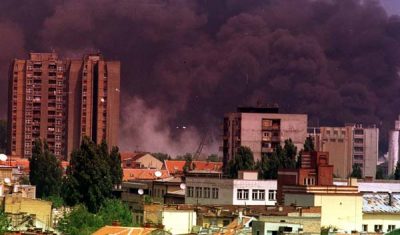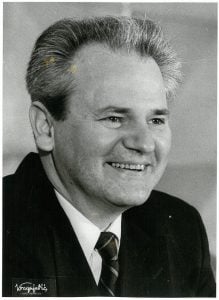NATO Demolishes Yugoslavia
The 70 Years of NATO: From War to War

The Following text is Section 3 of
The 70 Years of NATO: From War to War,
by the Italian Committee No War No NATO
*
Documentation presented at the International Conference on the 70th Anniversary of NATO, Florence, April 7, 2019
In the course of the next two weeks, Global Research will publish the 16 sections of this important document, which will also be available as an E-book.
*
Contents
1. NATO is born from the Bomb
2. In the post-Cold War, NATO is renewed
3. NATO demolishes the Yugoslav state
4. NATO expands eastward to Russia
5. US and NATO attack Afghanistan and Iraq
6. NATO demolishes the Libyan state
7. The US/NATO war to demolish Syria
8. Israel and the Emirates in NATO
9. The US/NATO orchestration of the coup in Ukraine
10. US/NATO escalation in Europe
11. Italy, the aircraft carrier on the war front
12. US and NATO reject the UN treaty and deploy new nuclear weapons in Europe
13. US and NATO sink the INF Treaty
14. The Western American Empire plays the war card
15. The US/NATO planetary war system
16. Exiting the war system of NATO
***
1. The “new strategic concept” of NATO was put into practice in the Balkans, where the crisis of the Yugoslav Federation, due to the contrasts between the power groups and the centrifugal thrusts of the republics, had reached the breaking point.
2. In November 1990, the Congress of the United States approved the direct funding of all the new “democratic” formations of Yugoslavia, thus encouraging secessionist tendencies. In December, the parliament of the Croatian Republic, controlled by the party of Franjo Tudjman, issued a new constitution according to which Croatia is only “home of the Croats” and is sovereign over its territory. Six months later, in June 1991, in addition to Croatia, Slovenia also proclaimed its independence. Immediately afterwards, clashes between the federal army and the separatists broke out. In October, in Croatia, the Tudjman government expeled over 25,000 Serbs while its militias occupied Vukovar. The federal army responded by taking the city back. The civil war began to spread, but it could still be stopped.
3. The path that was taken was instead diametrically opposite. Germany, committed to extending its economic and political influence in the Balkan region, in December 1991, unilaterally recognized Croatia and Slovenia as independent states. As a consequence, the day after, the Serbs of Croatia proclaimed self-determination, thereby forming the Serbian Republic of Krajna. In January 1992, first the Vatican and then the Europe of the Twelve recognized Slovenia as well as Croatia. At this point, Bosnia and Herzegovina were also set on fire, which, in a small way, represented the entire range of ethnic and religious nodes of the Yugoslavian Federation.
4. The UN blue helmets, sent to Bosnia as a force of interposition between the warring factions, was deliberately deployed in insufficient numbers and without adequate means nor precise directives, ending up becoming hostages in the middle of the fighting. Everything contributed to demonstrating the “failure of the UN” and the need for NATO to take matters into its own hands. In July 1992, NATO launched the first “crisis response” operation and imposed an embargo on Yugoslavia.
5. In February 1994, NATO aircraft shot down a Serbian-Bosnian aircraft flying over Bosnia. It was the first war action since the foundation of the Alliance. With it, NATO violated Article 5 of his own constituent charter, since the war action was not motivated by the attack on an Alliance member and was carried out outside its geographical area.
6. When the fire in Bosnia was extinguished (where the fire remained under the ashes of the division in ethnic states), NATO threw petrol on the Kosovo outbreak, where a claim of independence by the Albanian majority had been underway for years. Through underground channels largely managed by the CIA, a river of arms and funding, between the end of 1998 and the beginning of 1999, went to feed the KLA (Kosovo Liberation Army), an armed wing of the Kosovo separatist movement. Albanian. CIA agents later reported that they entered Kosovo in 1998 and 1999 as OSCE observers in charge of verifying the ceasefire, providing US military training manuals and satellite phones to the UCK so that the commanders of the guerrillas could stay in touch with NATO and Washington. The KLA could thus launch an offensive against Serbian federal troops and civilians, with hundreds of attacks and abductions.
7. While the clashes between the Yugoslav and KLA forces were provoking victims on both sides, a powerful political-media campaign prepared international public opinion for the intervention of NATO, presented as the only way to stop the “ethnic cleansing” of Serbians in Kosovo. A priority target was the president of Yugoslavia, Slobodan Milosevic, accused of “ethnic cleansing”.
8. The war, called “Operation Allied Force”, began March 24, 1999. The role of Italy was decisive. The D’Alema government put the Italian territory, particularly the airports, at the disposal of the United States armed forces and other countries to implement what the prime minister called “the right of humanitarian interference”. For 78 days, taking off mainly from the Italian bases, 1,100 planes made 38,000 sorties, releasing 23,000 bombs and missiles. 75 percent of the aircraft and 90 percent of the bombs and missiles were supplied by the United States. The US was also the communication, command, control and intelligence network through which operations were conducted. “Of the 2,000 targets hit by NATO aircraft in Serbia – later documented by the Pentagon – 1,999 were chosen by US intelligence and only one by Europeans.”
9. Systematically, the bombings dismantled the structures and infrastructure of Serbia, causing victims especially among civilians. The resulting damage to health and the environment was unquantifiable. Thousands of tons of highly toxic chemicals (including dioxins and mercury) came out of the Pancevo refinery alone. Other damage was caused by the massive use of depleted uranium projectiles by NATO in Serbia and Kosovo. These projectiles had already been used in the first Gulf War.
10. 54 Italian aircraft also took part in the bombings, attacking the objectives indicated by the US command. “By number of aircraft, we were second only to the USA. Italy is a great country, and we should not be surprised at the commitment shown in this war,” stated the president of the D’Alema council during a visit on 10 June 1999 at the base of Amendola, stressing that, for the pilots who participated in it, it was “a great human and professional experience”.
11. On June 10, 1999, Yugoslavian troops began to withdraw from Kosovo, and NATO put an end to the bombings. UN Security Council Resolution 1244 provided that the international presence must have “substantial NATO participation”. “Today, NATO faces its new mission: to govern”, commented The Washington Post.
12. After the war, more than 60 FBI agents were sent to Kosovo from the United States, but no traces of such excuses were found to justify the accusation made of the Serbs of “ethnic cleansing”. Slobodan Milosevic, of the former Yugoslavia, was sentenced to 40 years imprisonment by the International Criminal Court in The Hague. He died after five years in prison. The same court exonerated him in 2016 from the accusation of “ethnic cleansing”.
13. Kosovo, where the US installed a large military base (Camp Bondsteel), became a sort of NATO protectorate. At the same time, under the cover of the “Peace Force”, the former UCK in power terrorized and expelled over 250,000 Serbs, Roma, Jews and Albanians and branded them as collaborators. In 2008, with the self-proclamation of Kosovo as an independent state, the demolition of the Yugoslavian Federation was completed.
14. While the war against Yugoslavia was in progress, the summit that formalized the transformation of NATO was convened in Washington on April 23-25, 1999, by an alliance which, pursuant to Article 5 of the Treaty of 4 April 1949, commited member countries to assist the armed forces of a member country which is attacked in the North-Atlantic area. It was transformed into an alliance which, on the basis of the “new strategic concept” also commited member countries to “conduct crisis response operations not provided for by Article 5 outside the territory of the Alliance”. In other words, NATO was preparing to project its military force beyond its borders not only in Europe but also in other regions of the world.
15. What did not change in the mutation of NATO was the hierarchy within it. The President of the United States has always been able to appoint the Supreme Allied Commander in Europe, who is still a US general, while the Allies can merely ratifying the President’s choice. The same is true for the other key commands.
16. The document that commited member countries to operate outside the Alliance, signed by European leaders on April 24, 1999 in Washington, reaffirmed that NATO “fully supports the development of the European defense identity within the Alliance”. The concept is clear: Western Europe can have its own “defense identity”, but it must remain within the Alliance, i.e. under US command.
17. The subordination of the European Union to NATO was thus confirmed and consolidated. Subordination established by the Treaty of Maastricht of 1992, which recognized the right of the EU States to be part of NATO, was defined as the foundation of the defense of the European Union.
18. By participating in the war against Yugoslavia, a country that had not taken any aggressive action against either Italy or against other NATO members, Italy confirmed that it had adopted a new military policy and, at the same time, a new foreign policy. Since this involved using military force as a tool, it violated the constitutional principle, affirmed by Article 11, that “Italy repudiates war as an instrument of offense against the freedom of other peoples and as a means of resolving international disputes”.
*
Sections 4-16 of the 70 Years of NATO, From War to War, forthcoming on Global Research
This text was translated from the Italian document which was distributed to participants at the April 7 Conference. It does not include sources and references.
Note to readers: please click the share buttons below. Forward this article to your email lists. Crosspost on your blog site, internet forums. etc.


